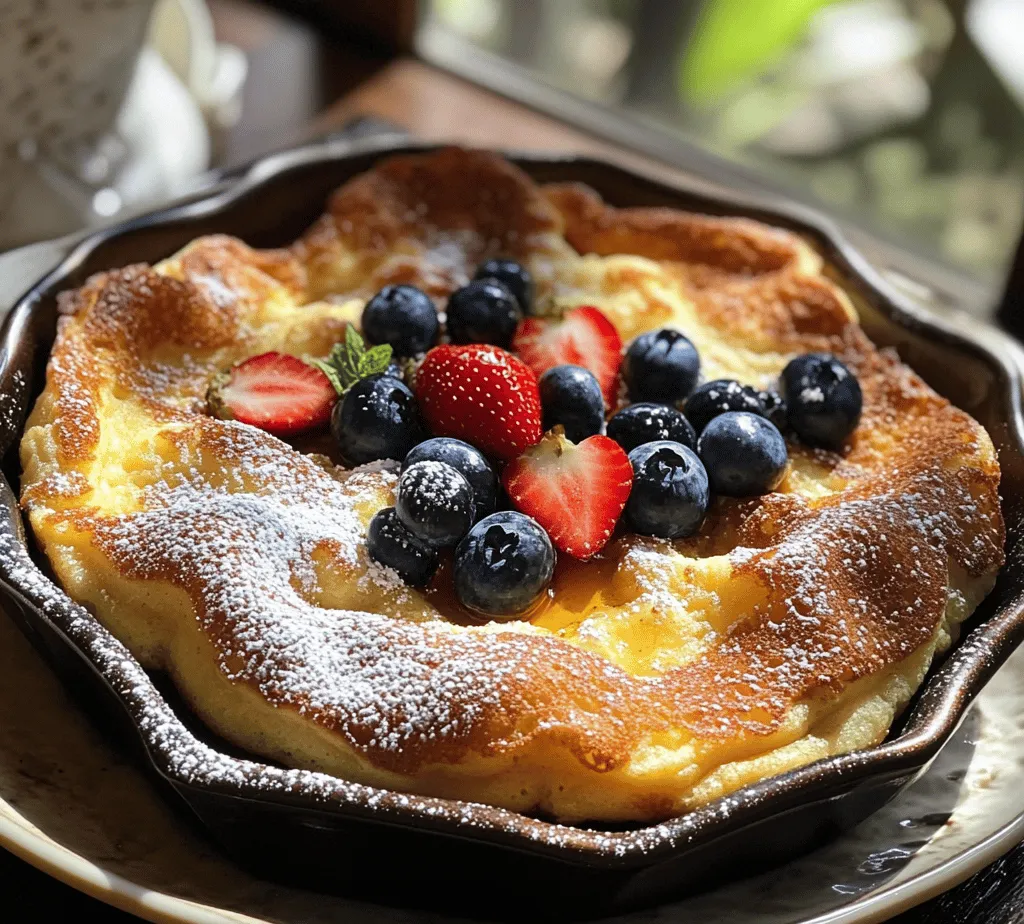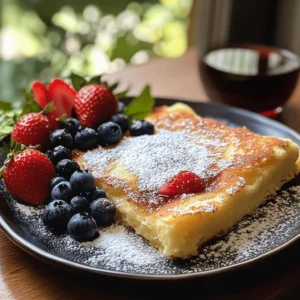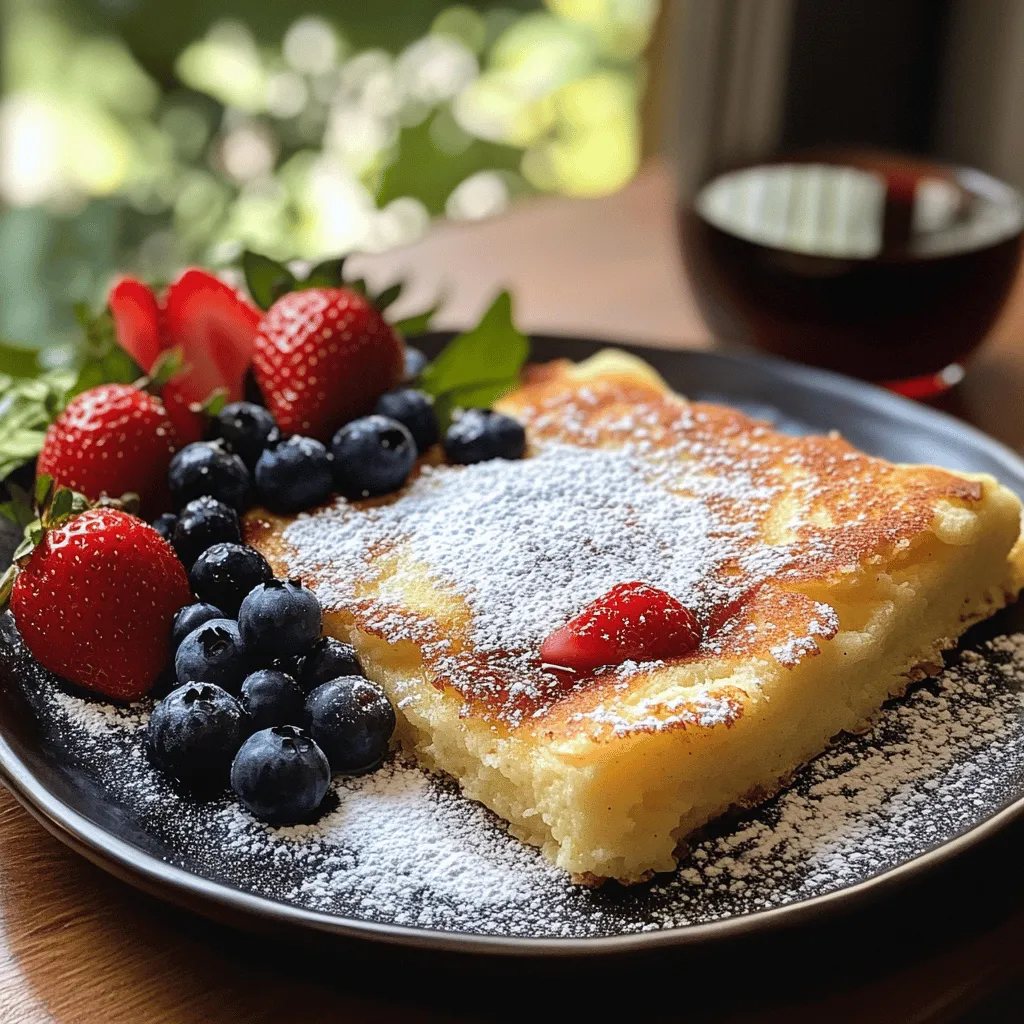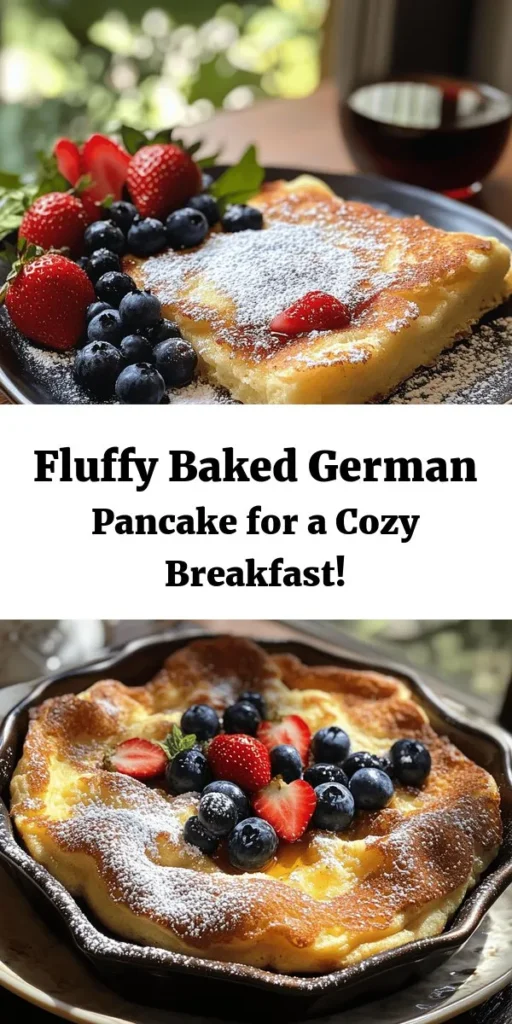Introduction
Are you ready to indulge in a breakfast dish that’s as delightful to the eyes as it is to the palate? The Fluffy German Pancake, also known as a Dutch Baby, is a culinary creation that has captured hearts globally with its airy texture and impressive presentation. Originating from Germany, this pancake is not your run-of-the-mill breakfast fare; it’s a unique treat that puffs up beautifully in the oven, creating a fluffy, golden-brown delight that can be topped with fruits, powdered sugar, or syrup.
What sets the Fluffy German Pancake apart from its traditional counterparts is not just its unique cooking method but also its simplicity. Made with a handful of basic ingredients, this recipe allows for a quick preparation that is perfect for busy mornings or leisurely brunches. With the ease of combining the ingredients and letting the oven do the work, this dish stands out as a convenient choice for families and entertaining guests.
In this article, we will dive deeper into the history of the Baked German Pancake, explore its essential ingredients, and provide you with a step-by-step guide to creating your own fluffy masterpiece.
Understanding the Baked German Pancake
To truly appreciate the Fluffy German Pancake, it’s essential to understand its rich history and culinary significance. The origins of German pancakes can be traced back to the 19th century, where they were influenced by traditional German cooking methods. Although similar to crepes, this dish is baked rather than fried, which allows it to achieve its signature puffiness.
In contrast to traditional pancakes, which are often cooked on a griddle and flipped to achieve a golden-brown exterior, the Baked German Pancake is prepared in a hot oven, where it rises dramatically due to the steam produced from the eggs and milk. This cooking method not only contributes to its fluffy texture but also results in a dish that is crispy around the edges while remaining soft and custardy in the center.
Additionally, the Baked German Pancake has a close resemblance to other dishes, such as Dutch Babies and popovers, further showcasing its versatility within breakfast and brunch menus. The appeal of this pancake lies in its ability to be customized with various toppings, making it suitable for both sweet and savory palates. Whether you prefer a dusting of powdered sugar with fresh berries or a drizzle of maple syrup, the possibilities are endless.
Essential Ingredients for a Perfect Baked German Pancake
Creating a Fluffy German Pancake requires just a few essential ingredients, each playing a crucial role in ensuring the final result is both delicious and visually appealing. Let’s break down each ingredient and its importance in this delightful recipe.
Eggs
Eggs are the backbone of the Baked German Pancake, providing structure and stability while contributing to its signature fluffiness. The proteins in eggs coagulate during baking, creating a network that holds the pancake’s airy structure once it has risen.
Milk
Milk adds moisture and richness to the pancake, enhancing its flavor and creating a tender crumb. The fat content in milk also contributes to a creamy texture, making each bite feel indulgent.
All-Purpose Flour
All-purpose flour serves as the base of the pancake, providing stability and structure. It absorbs moisture and helps create a cohesive batter that bakes into a puffy, golden delight.
Granulated Sugar
Sugar not only adds a touch of sweetness but also aids in browning the pancake as it bakes. This caramelization creates a beautiful golden crust, enhancing the overall flavor profile.
Vanilla Extract
A splash of vanilla extract adds depth and complexity to the flavor of the pancake. It complements the sweetness and elevates the overall taste experience, making each bite feel special.
Salt
Though often overlooked, salt is a critical ingredient that enhances the overall taste of the pancake. It balances the sweetness and helps to bring out the flavors of the other ingredients.
Unsalted Butter
Unsalted butter plays a dual role in this recipe. Firstly, it adds rich flavor to the pancake, and secondly, it is used to grease the baking dish. When melted, it creates crispy edges that contrast beautifully with the soft interior.
Optional Toppings
The Fluffy German Pancake is incredibly versatile and can be topped with a variety of ingredients to suit your taste. Fresh fruits, such as berries or sliced bananas, can add a burst of freshness, while a drizzle of maple syrup or a dusting of powdered sugar elevates the dish to indulgent heights. Other options include whipped cream, lemon juice, or even a sprinkle of nuts for added texture.
Step-by-Step Guide to Making Fluffy Delight: Baked German Pancake
Now that we’ve explored the history and ingredients that make the Baked German Pancake a standout dish, let’s dive into the step-by-step guide to making your very own Fluffy Delight. This process is straightforward and requires minimal effort, allowing you to enjoy a delicious homemade pancake without the fuss.
Step 1: Preheat the Oven
Begin by preheating your oven to 425°F (220°C). A hot oven is essential for achieving the pancake’s characteristic puffiness, so don’t skip this step!
Step 2: Prepare the Baking Dish
While the oven is heating, take a 10-inch cast-iron skillet or an oven-safe baking dish and place it in the oven to heat as well. This will ensure that the butter melts quickly and helps to create crispy edges.
Step 3: Whisk the Batter
In a mixing bowl, combine the eggs, milk, all-purpose flour, granulated sugar, vanilla extract, and salt. Using a whisk or a blender, beat the mixture until it is smooth and well-combined. Be sure not to overmix; a few lumps are perfectly fine.
Step 4: Melt the Butter
Once the oven is preheated, carefully remove the hot skillet from the oven. Add the unsalted butter to the skillet, allowing it to melt and coat the bottom of the pan evenly.
Step 5: Pour in the Batter
After the butter has melted, pour the prepared batter into the skillet. The hot skillet will cause the edges to start cooking immediately, contributing to the pancake’s puffiness.
Step 6: Bake
Return the skillet to the oven and bake for 20-25 minutes, or until the pancake is puffed up and golden brown. Avoid opening the oven door during the baking process, as this can cause the pancake to deflate.
Step 7: Serve Immediately
Once baked, remove the skillet from the oven. The pancake will start to deflate slightly as it cools, so it’s best to serve it immediately. Top with your favorite toppings, slice, and enjoy this fluffy delight!
Stay tuned for the next part of this article, where we’ll delve into tips for achieving the perfect Fluffy German Pancake and answer some common questions about this delectable dish. Whether you’re a seasoned chef or a beginner in the kitchen, this pancake is sure to impress and become a favorite in your breakfast repertoire.

Preparation Steps Before Baking
Before diving into the actual baking of your Fluffy Delight: Baked German Pancake, it’s essential to prepare your ingredients and kitchen space. Gather all the necessary ingredients: eggs, milk, flour, sugar, vanilla extract, and salt. Having everything within reach will streamline the cooking process and help you avoid last-minute scrambles for forgotten items.
It’s also wise to measure out your ingredients beforehand. This not only saves time but ensures accurate measurements, which are crucial for achieving the perfect texture and flavor.
Importance of Preheating the Oven and Baking Dish
One of the key elements to a successful baked German pancake is proper preheating. Begin by preheating your oven to 425°F (220°C). This high temperature is vital for achieving that characteristic puffiness and golden-brown crust.
Additionally, while your oven is heating, place your baking dish (a cast-iron skillet or glass dish works wonderfully) in the oven to heat up as well. The combination of a preheated dish and oven creates an instant burst of heat when the batter is poured in, resulting in a beautifully puffy pancake.
How to Prepare the Batter for Optimal Fluffiness
Creating the batter for your baked German pancake is both simple and crucial for achieving that fluffy texture. In a large mixing bowl, start by whisking together the eggs until they are frothy. This aeration is vital as it introduces air into the batter, contributing to the fluffiness of the finished pancake.
Next, add in the milk, sugar, vanilla extract, and salt, whisking until well combined. Then, gradually sift in the flour, mixing gently until just combined. Be careful not to over-mix; a few lumps are perfectly fine. The batter should be smooth but not overworked, as excess gluten development can lead to a denser pancake.
Detailed Baking Instructions
Once your batter is ready and your oven is preheated, carefully remove the hot baking dish from the oven using oven mitts. Add a generous amount of butter (about 2 to 4 tablespoons) to the hot dish, allowing it to melt and coat the bottom and sides. This prevents sticking and adds a delicious buttery flavor.
Pour the batter into the hot, buttered dish and return it to the oven immediately. Bake for 20 to 25 minutes.
Importance of Timing and Temperature for Perfect Puffing
Timing and temperature are crucial when baking your German pancake. The high heat of 425°F is essential for creating steam within the batter, which helps it rise dramatically. Keep an eye on the clock and avoid opening the oven door during the first 15 minutes of baking. This will help maintain the oven temperature, ensuring your pancake puffs up perfectly.
Visual Cues to Look For During Baking
As your pancake bakes, observe the transformation. It will start to rise in the edges and form a golden-brown crust. The center might still be slightly jiggly when it’s done, but the outer edges should look firm. A perfectly baked German pancake will have a puffy, billowing appearance, and will begin to slightly deflate once removed from the oven due to the cooling process.
Serving Suggestions and Presentation Tips
When the pancake is done baking, remove it from the oven and let it rest for a minute. For serving, use a sharp knife to slice it into wedges or squares. Consider serving it directly from the baking dish for a rustic presentation, or transfer it to a large platter.
To elevate your serving presentation, dust the top with powdered sugar or serve with fresh fruit, whipped cream, or a drizzle of maple syrup. The contrast of the fluffy pancake with bright, colorful toppings will make your dish visually appealing.
Ideal Ways to Cut and Serve the Pancake
Cutting the pancake into manageable portions is easy, as it retains its structure well. Use a sharp serrated knife to slice through the pancake gently. Each piece should be able to stand on its own thanks to the pancake’s height and fluffiness. Serve warm for the best experience.
Creative Topping Ideas Beyond the Basics
While your baked German pancake is delicious on its own, topping it can elevate the entire breakfast experience. Here are some creative ideas:
– Fresh Berries: Strawberries, blueberries, or raspberries add a sweet-tart flavor.
– Caramelized Apples: Sautéed apples with cinnamon and sugar create an autumnal delight.
– Nut Butter: Spread almond or peanut butter for added protein and richness.
– Chocolate Drizzle: A drizzle of melted chocolate or Nutella can make it a decadent treat.
– Lemon Curd: For a tangy twist, serve with lemon curd and a dollop of cream.
Tips for Perfecting Your Baked German Pancake
Common Pitfalls to Avoid When Making the Recipe
To ensure your pancake turns out perfectly, be mindful of these common pitfalls:
– Skipping Preheating: Not preheating your oven or baking dish can lead to a flat pancake.
– Overmixing the Batter: Over-mixing can lead to a tough texture; stop mixing as soon as the flour is incorporated.
– Incorrect Oven Temperature: An oven that is too hot or too cool can ruin the pancake, so use an oven thermometer if needed.
Adjustments for Different Dietary Preferences
If you or your guests have dietary restrictions, here are some easy adjustments:
– Gluten-Free: Substitute all-purpose flour with a gluten-free flour blend or almond flour.
– Dairy-Free: Use almond milk or oat milk instead of regular milk, and opt for a dairy-free butter substitute.
Storage and Reheating Instructions for Leftovers
If you have leftovers (though they are unlikely!), store any uneaten pancake in an airtight container in the refrigerator for up to 2 days. When ready to enjoy, reheat slices in a toaster oven or microwave until warmed through. For a crispier texture, reheat in a skillet over medium heat.
Flavor Variations and Customizations
Suggestions for Flavoring the Pancake
For those looking to customize their pancake, consider adding spices or zests to the batter:
– Cinnamon: A teaspoon of cinnamon adds warmth and depth.
– Lemon Zest: A bit of lemon zest brightens the flavor profile.
Ideas for Seasonal Toppings
Adapt your toppings to the season to keep things fresh:
– Autumn Spices: Top with cinnamon, nutmeg, and roasted pecans in fall.
– Summer Fruits: Fresh peaches or cherries with a scoop of vanilla ice cream in summer.
How to Incorporate Different Ingredients for a Unique Twist
Experiment with different mix-ins, such as chocolate chips, nuts, or shredded coconut. You can fold these into the batter before baking for an added layer of flavor and texture.
Conclusion
The Fluffy Delight: Baked German Pancake is not just a breakfast dish; it’s a celebration of simplicity and flavor, perfect for impressing guests or enjoying a cozy family brunch. With its effortless preparation and impressive presentation, this dish encapsulates the joy of homemade cooking.
Encouraging you to try making this easy yet impressive dish, remember that sharing food with family and friends creates lasting memories. Whether you stick to traditional toppings or get creative with seasonal flavors, this baked pancake is sure to become a beloved staple in your kitchen. Enjoy the delightful experience of creating something special, and savor every fluffy, delicious bite.



